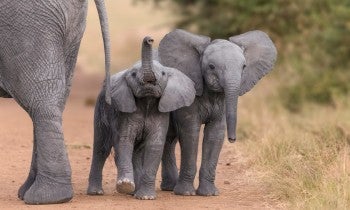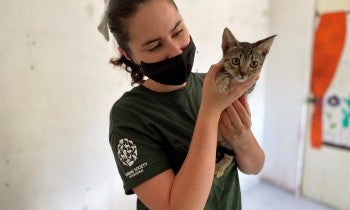Search
Found 3955 results
Appello di 137 ONG di tutto il mondo per vietare le importazioni di trofei di caccia
BRUXELLES—In un documento che delinea la posizione comune di 137 organizzazioni per la conservazione e la protezione degli animali di tutto il mondo, tra cui 45 organizzazioni non governative provenienti da Paesi africani, le stesse si esprimono contro la caccia ai trofei e esortano i decisori
137 organizacji pozarządowych z całego świata apeluje o zakaz importu trofeów łowieckich
KRAKÓW, Polska—Wspólny apel 137 organizacji zajmujących się ochroną przyrody i prawami zwierząt, w tym 45 organizacji z Afryki, wzywa polityków do wprowadzenia zakazu importu trofeów łowieckich już teraz. „Polowania dla trofeów są najgorszą formą eksploatacji świata przyrody i nigdy nie były ani
Humane Society International trains authorities in Mexico City, Yucatan and Aguascalientes on animal protection issues
MEXICO CITY—In recent days, a team of disaster and animal cruelty response experts from Humane Society International presented and hosted workshops covering animal welfare issues for federal and local authorities and nonprofit organizations from Mexico City, Tlaxcala, Pachuca, Estado de México
Humane Society International capacita a autoridades de la Ciudad de México, Yucatán y Aguascalientes en temas de protección animal
CIUDAD DE MÉXICO—En los últimos días, un equipo de expertos en respuesta a desastres y crueldad animal de Humane Society International presentó y organizó talleres sobre bienestar animal para autoridades federales y locales y organizaciones sin fines de lucro de la Ciudad de México, Tlaxcala
137 NGOs aus aller Welt fordern ein Importverbot von Jagdtrophäen
BRÜSSEL—In einem gemeinsamen Positionspapier sprechen sich 137 Natur- und Tierschutzorganisationen aus der ganzen Welt, darunter 45 NGOs aus afrikanischen Ländern, gegen die Trophäenjagd aus und fordern von der Politik, die Einfuhr von Jagdtrophäen zu verbieten. Dr. Mona Schweizer von Pro Wildlife
Days before Bok Nal season, Korean animal groups HSI/Korea and Korean K9 Rescue unite to save 21 dogs left behind on an illegal dog meat farm
SEOUL—Twenty-one dogs left behind when authorities closed an illegal dog meat farm in Gyeonggi-do, South Korea, have been saved by animal groups just days before the start of Bok Nal—the three hottest days of summer during which most dogs on farms are sold and killed for dog meat soup, known as
Trophy hunting: Nine out of 10 Argentines are against this practice
BUENOS AIRES, Argentina—The vast majority of Argentine society opposes trophy hunting in the country and the export and import of trophies. This was demonstrated by the results of a recent survey conducted in Argentina in May 2022 regarding this practice, which consists of killing animals for
Caza de trofeos: 9 de cada 10 argentinos están en contra de esta práctica
BUENOS AIRES, Argentina—La sociedad argentina le dice basta a la caza de trofeos en el país y a la exportación e importación de los trofeos. Así lo demuestran los resultados de una encuesta realizada en Argentina para conocer la opinión respecto de esta práctica, que consiste en matar animales para
Visoni: allevamenti chiusi, animali ancora in gabbia.
ROMA—Dal 1° gennaio di quest’anno, come stabilito dalla Legge di bilancio 2022 ( L. 234 del 30 dicembre 2021, art. 1, commi 980-984), in Italia è vietato allevare animali da pelliccia: è una vittoria storica per la quale le associazioni si battono da sempre. Resta il problema dei circa 5.700 visoni
Durchbruch im Tierschutz: Rumänien verbietet die Pelztierzucht!
BUCHAREST/BERLIN—Humane Society International/Europe (HSI/Europe) feiert heute einen monumentalen Sieg für den Tierschutz in Rumänien. Um 12 Uhr Ortszeit (11 Uhr MEZ) stimmte das rumänische Parlament mit überwältigender Mehrheit für ein Verbot der Zucht von Chinchillas und Nerzen, den einzigen
Victory: Romania bans fur farming!
BUCHAREST/BRUSSELS—Humane Society International/Europe is celebrating a monumental victory for animal protection in Romania today, as the Romanian Parliament has voted overwhelmingly to ban chinchilla and mink fur farming, the only two fur farm industries that exist in the country. This
Victorie: România interzice fermele de blănuri!
BUCUREȘTI—Humane Society International/Europe sărbătorește astăzi o victorie majoră pentru protecția animalelor din România, după ce Parlamentul României a votat cu o majoritate covârșitoare pentru interzicerea fermelor de șinșile și nurci, singurele ferme de blănuri din țară. Această decizie
Secret filming shows rooms stacked full of caged chinchillas in Romania’s filthy fur factory farms, sparking calls for a ban
BUCHAREST, Romania—Romania is being urged to become the 20 th country in Europe to ban fur farming following revelations from an undercover investigation by Humane Society International/Europe which uncovers serious animal welfare concerns. Following discussion with HSI/Europe, deputies from the
Geheimes Filmmaterial zeigt Chinchillas in grausamen Pelzfabriken in Rumänien und führt zu Forderungen nach einem Verbot der Pelztierzucht
BUKAREST, Rumänien—Rumänien wird aufgefordert, das 20. Land in Europa zu werden, das die Pelztierzucht verbietet, nachdem eine verdeckte Untersuchung von Humane Society International/Europe schwerwiegende Tierschutzverstöße auf Pelzfarmen aufgedeckt hat. Nach Gesprächen mit HSI/Europe haben
Nuova indagine sotto copertura getta luce sulle terribili condizioni dei cincillà negli allevamenti di animali da pelliccia in Romania, scatenando le richieste per un divieto nel paese
BUCAREST, Romania—Dopo la diffusione di un’ indagine sotto copertura di Humane Society International/Europe, che ha portato alla luce gravi problemi di benessere animale, la Romania potrebbe diventare il ventesimo Paese europeo a vietare l’allevamento di animali da pelliccia. Questa è la richiesta
Nagrania ze śledztwa ukazują okrutne realia rumuńskich hodowli szynszyli na futra, wywołując apele o wprowadzenia zakazu
BUKARESZT, Rumunia—Po opublikowaniu śledztwa przeprowadzonego przez Humane Society International/Europe na rumuńskich fermach szynszyli, które ujawniło poważne problemy związane z dobrostanem zwierząt, aktywiści apelują aby Rumunia została 20. krajem w Europie zakazującym hodowli zwierząt na futro
Filmări cu camera ascunsă arată stive de cuști cu șinșile în ferme mizerabile din România, generând apeluri pentru interzicerea fermelor de animale de blană
BUCUREȘTI, România—României i se solicită să devină cea de-a 20-a țară din Europa care interzice creșterea animalelor pentru blană, în urma unei investigații sub acoperire a organizației Humane Society International/Europe, care dezvăluie probleme serioase legate de bunăstarea animalelor. În urma
Oltre 110.000 cittadini italiani chiedono la fine dell’era delle gabbie, il governo li ascolti
ROMA—“Abbiamo portato all’attenzione del Governo la voce di 110.233 cittadine e cittadini italiani. Ci aspettiamo che l’Italia faccia la sua parte per la transizione ad un’Europa senza gabbie.” Questo il commento delle associazioni italiane per la tutela degli animali e dell’ambiente che lunedì 12
HSI/Korea welcomes regulatory uptake of horseshoe crab test replacement method
SEOUL—Animal protection organization Humane Society International Korea (HSI/Korea) welcomes the Ministry of Food and Drug Safety’s announcement of a phaseout of the use of horseshoe crab blood for toxicity tests. Alternatives are available, and a synthetic recombinant Factor C (rFC) will be used
Island stellt aus Gründen des Tierschutzes den kommerziellen Walfang für diese Saison ein
BERLIN―Angesichts der Nachricht, dass Island den kommerziellen Walfang für diese Saison aus Gründen des Tierschutzes eingestellt hat, zeigt sich die weltweit tätige Tierschutzorganisation Humane Society International (HSI) erfreut und erleichtert über die Ankündigung, die Hunderten Walen einen










